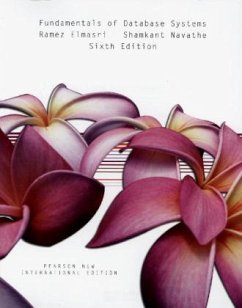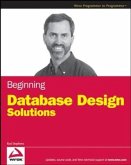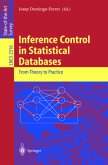Clear explanations of theory and design, broad coverage of models and real systems, and an up-to-date introduction to modern database technologies result in a leading introduction to database systems. Intended for computer science majors, this text emphasizes math models, design issues, relational algebra, and relational calculus.
A lab manual and problems give students opportunities to practice the fundamentals of design and implementation. Real-world examples serve as engaging, practical illustrations of database concepts. The Sixth Edition maintains its coverage of the most popular database topics, including SQL, security, and data mining, and features increased emphasis on XML and semi-structured data.
Features + Benefits
This market-leading text serves as a valued reference for those who will interact with databases in future courses and careers. Renowned for its accessible, comprehensive coverage, it provides a solid introduction to database systems and applications.
Extensive coverage includes:
Basic topics such as modeling, diagrams, relational algebra/calculus, SQL, normalization.
Advanced object database, mining, XML, and security.
Advanced modeling discussions in the areas of active, temporal, and spatial databases.
Physical database design and tuning.
Current database application areas of GIS, genome, and digital libraries.
The relational approach, including modeling, design, algebra and calculus, and query languages.
Both traditional ER model and UML in data modeling material.
SUPPLEMENTS
Companion Website (Password Protected, access code required)
PPTs - New
Instructor Solutions Manual - New
Online Lab Manual
CourseSmart
Part 1: Introduction to Databases
Chapter 1 Databases and Database Users 3
1.1 Introduction 4
1.2 An Example 6
1.3 Characteristics of the Database Approach 9
1.4 Actors on the Scene 14
1.5 Workers behind the Scene 16
1.6 Advantages of Using the DBMS Approach 17
1.7 A Brief History of Database Applications 23
1.8 When Not to Use a DBMS 26
1.9 Summary 27
Review Questions 27
Exercises 28
Selected Bibliography 28
Chapter 2 Database System Concepts and Architecture 29
2.1 Data Models, Schemas, and Instances 30
2.2 Three-Schema Architecture and Data Independence 33
2.3 Database Languages and Interfaces 36
2.4 The Database System Environment 40
2.5 Centralized and Client/Server Architectures for DBMSs 44
2.6 Classification of Database Management Systems 49
2.7 Summary 52
Review Questions 53
Exercises 54
Selected Bibliography 55
Part 2: Relational Data Model and SQL
Chapter 3 The Relational Data Model and Relational Database Constraints 59
3.1 Relational Model Concepts 60
3.2 Relational Model Constraints and Relational Database Schemas 67
3.3 Update Operations, Transactions, and Dealing with Constraint Violations 75
3.4 Summary 79
Review Questions 80
Exercises 80
Selected Bibliography 85
Chapter 4 Basic SQL 87
4.1 SQL Data Definition and Data Types 89
4.2 Specifying Constraints in SQL 94
4.3 Basic Retrieval Queries in SQL 97
4.4 INSERT, DELETE, and UPDATE Statements in SQL 107
4.5 Additional Features of SQL 110
4.6 Summary 111
Review Questions 112
Exercises 112
Selected Bibliography 114
Chapter 5 More SQL: Complex Queries, Triggers, Views, and Schema Modification 115
5.1 More Complex SQL Retrieval Queries 115
5.2 Specifying Constraints as Assertions and Actions as Triggers 131
5.3 Views (Virtual Tables) in SQL 133
5.4 Schema Change Statements in SQL 137
5.5 Summary 139
Review Questions 141
Exercises 141
Selected Bibliography 143
Chapter 6 The Relational Algebra and Relational Calculus 145
6.1 Unary Relational Operations: SELECT and PROJECT 147
6.2 Relational Algebra Operations from Set Theory 152
6.3 Binary Relational Operations: JOIN and DIVISION 157
6.4 Additional Relational Operations 165
6.5 Examples of Queries in Relational Algebra 171
6.6 The Tuple Relational Calculus 174
6.7 The Domain Relational Calculus 183
6.8 Summary 185
Review Questions 186
Exercises 187
Laboratory Exercises 192
Selected Bibliography 194
Part 3: Conceptual Modeling and Database Design
Chapter 7 Data Modeling Using the Entity-Relationship (ER) Model 199
7.1 Using High-Level Conceptual Data Models for Database Design 200
7.2 A Sample Database Application 202
7.3 Entity Types, Entity Sets, Attributes, and Keys 203
7.4 Relationship Types, Relationship Sets, Roles, and Structural Constraints 212
7.5 Weak Entity Types 219
7.6 Refining the ER Design for the COMPANY Database 220
7.7 ER Diagrams, Naming Conventions, and Design Issues 221
7.8 Example of Other Notation: UML Class Diagrams 226
7.9 Relationship Types of Degree Higher than Two 228
7.10 Summary 232
Review Questions 234
Exercises 234
Laboratory Exercises 241
Selected Bibliography 243
Chapter 8 The Enhanced Entity-Relationship (EER) Model 245
8.1 Subclasses, Superclasses, and Inheritance 246
8.2 Specialization and Generalization 248
8.3 Constraints and Characteristics of Specialization and Generalization Hierarchies 251
8.4 Modeling of UNION Types Using Categories 258
8.5 A Sample UNIVERSITY EER Schema, Design Choices, and Formal Definitions 260
8.6 Example of Other Notation: Representing Specialization and Generalization in UML Class Diagrams 265
8.7 Data Abstraction, Knowledge Representation, and Ontology Concepts 267
8.8 Summary 273
Review Questions 273
Exercises 274
Laboratory Exercises 281
Selected Bibliography 284
Chapter 9 Relational Database Design by ERand EER-to-Relational Mapping 285
9.1 Relational Database Design Using ER-to-Relational Mapping 286
9.2 Mapping EER Model Constructs to Relations 294
9.3 Summary 299
Review Questions 299
Exercises 299
Laboratory Exercises 301
Selected Bibliography 302
Chapter 10 Practical Database Design Methodology and Use of UML Diagrams 303
10.1 The Role of Information Systems in Organizations 304
10.2 The Database Design and Implementation Process 309
10.3 Use of UML Diagrams as an Aid to Database Design Specification 328
10.4 Rational Rose: A UML-Based Design Tool 337
10.5 Automated Database Design Tools 342
10.6 Summary 345
Review Questions 347
Selected Bibliography 348
Part 4: Object, Object-Relational, and XML Models
Chapter 11 Object and Object-Relational Databases 353
11.1 Overview of Object Database Concepts 355
11.2 Object-Relational Features: Object Database Extensions to SQL 369
11.3 The ODMG Object Model and the Object Definition Language ODL 376
11.4 Object Database Conceptual Design 395
11.5 The Object Query Language OQL 398
11.6 Overview of the C++ Language Binding in the ODMG Standard 407
11.7 Summary 408
Review Questions 409
Exercises 411
Selected Bibliography 412
Chapter 12 XML: Extensible Markup Language 415
12.1 Structured, Semistructured, and Unstructured Data 416
12.2 XML Hierarchical (Tree) Data Model 420
12.3 XML Documents, DTD, and XML Schema 423
12.4 Storing and Extracting XML Documents from Databases 431
12.5 XML Languages 432
12.6 Extracting XML Documents from Relational Databases 436
12.7 Summary 442
Review Questions 442
Exercises 443
Selected Bibliog
A lab manual and problems give students opportunities to practice the fundamentals of design and implementation. Real-world examples serve as engaging, practical illustrations of database concepts. The Sixth Edition maintains its coverage of the most popular database topics, including SQL, security, and data mining, and features increased emphasis on XML and semi-structured data.
Features + Benefits
This market-leading text serves as a valued reference for those who will interact with databases in future courses and careers. Renowned for its accessible, comprehensive coverage, it provides a solid introduction to database systems and applications.
Extensive coverage includes:
Basic topics such as modeling, diagrams, relational algebra/calculus, SQL, normalization.
Advanced object database, mining, XML, and security.
Advanced modeling discussions in the areas of active, temporal, and spatial databases.
Physical database design and tuning.
Current database application areas of GIS, genome, and digital libraries.
The relational approach, including modeling, design, algebra and calculus, and query languages.
Both traditional ER model and UML in data modeling material.
SUPPLEMENTS
Companion Website (Password Protected, access code required)
PPTs - New
Instructor Solutions Manual - New
Online Lab Manual
CourseSmart
Part 1: Introduction to Databases
Chapter 1 Databases and Database Users 3
1.1 Introduction 4
1.2 An Example 6
1.3 Characteristics of the Database Approach 9
1.4 Actors on the Scene 14
1.5 Workers behind the Scene 16
1.6 Advantages of Using the DBMS Approach 17
1.7 A Brief History of Database Applications 23
1.8 When Not to Use a DBMS 26
1.9 Summary 27
Review Questions 27
Exercises 28
Selected Bibliography 28
Chapter 2 Database System Concepts and Architecture 29
2.1 Data Models, Schemas, and Instances 30
2.2 Three-Schema Architecture and Data Independence 33
2.3 Database Languages and Interfaces 36
2.4 The Database System Environment 40
2.5 Centralized and Client/Server Architectures for DBMSs 44
2.6 Classification of Database Management Systems 49
2.7 Summary 52
Review Questions 53
Exercises 54
Selected Bibliography 55
Part 2: Relational Data Model and SQL
Chapter 3 The Relational Data Model and Relational Database Constraints 59
3.1 Relational Model Concepts 60
3.2 Relational Model Constraints and Relational Database Schemas 67
3.3 Update Operations, Transactions, and Dealing with Constraint Violations 75
3.4 Summary 79
Review Questions 80
Exercises 80
Selected Bibliography 85
Chapter 4 Basic SQL 87
4.1 SQL Data Definition and Data Types 89
4.2 Specifying Constraints in SQL 94
4.3 Basic Retrieval Queries in SQL 97
4.4 INSERT, DELETE, and UPDATE Statements in SQL 107
4.5 Additional Features of SQL 110
4.6 Summary 111
Review Questions 112
Exercises 112
Selected Bibliography 114
Chapter 5 More SQL: Complex Queries, Triggers, Views, and Schema Modification 115
5.1 More Complex SQL Retrieval Queries 115
5.2 Specifying Constraints as Assertions and Actions as Triggers 131
5.3 Views (Virtual Tables) in SQL 133
5.4 Schema Change Statements in SQL 137
5.5 Summary 139
Review Questions 141
Exercises 141
Selected Bibliography 143
Chapter 6 The Relational Algebra and Relational Calculus 145
6.1 Unary Relational Operations: SELECT and PROJECT 147
6.2 Relational Algebra Operations from Set Theory 152
6.3 Binary Relational Operations: JOIN and DIVISION 157
6.4 Additional Relational Operations 165
6.5 Examples of Queries in Relational Algebra 171
6.6 The Tuple Relational Calculus 174
6.7 The Domain Relational Calculus 183
6.8 Summary 185
Review Questions 186
Exercises 187
Laboratory Exercises 192
Selected Bibliography 194
Part 3: Conceptual Modeling and Database Design
Chapter 7 Data Modeling Using the Entity-Relationship (ER) Model 199
7.1 Using High-Level Conceptual Data Models for Database Design 200
7.2 A Sample Database Application 202
7.3 Entity Types, Entity Sets, Attributes, and Keys 203
7.4 Relationship Types, Relationship Sets, Roles, and Structural Constraints 212
7.5 Weak Entity Types 219
7.6 Refining the ER Design for the COMPANY Database 220
7.7 ER Diagrams, Naming Conventions, and Design Issues 221
7.8 Example of Other Notation: UML Class Diagrams 226
7.9 Relationship Types of Degree Higher than Two 228
7.10 Summary 232
Review Questions 234
Exercises 234
Laboratory Exercises 241
Selected Bibliography 243
Chapter 8 The Enhanced Entity-Relationship (EER) Model 245
8.1 Subclasses, Superclasses, and Inheritance 246
8.2 Specialization and Generalization 248
8.3 Constraints and Characteristics of Specialization and Generalization Hierarchies 251
8.4 Modeling of UNION Types Using Categories 258
8.5 A Sample UNIVERSITY EER Schema, Design Choices, and Formal Definitions 260
8.6 Example of Other Notation: Representing Specialization and Generalization in UML Class Diagrams 265
8.7 Data Abstraction, Knowledge Representation, and Ontology Concepts 267
8.8 Summary 273
Review Questions 273
Exercises 274
Laboratory Exercises 281
Selected Bibliography 284
Chapter 9 Relational Database Design by ERand EER-to-Relational Mapping 285
9.1 Relational Database Design Using ER-to-Relational Mapping 286
9.2 Mapping EER Model Constructs to Relations 294
9.3 Summary 299
Review Questions 299
Exercises 299
Laboratory Exercises 301
Selected Bibliography 302
Chapter 10 Practical Database Design Methodology and Use of UML Diagrams 303
10.1 The Role of Information Systems in Organizations 304
10.2 The Database Design and Implementation Process 309
10.3 Use of UML Diagrams as an Aid to Database Design Specification 328
10.4 Rational Rose: A UML-Based Design Tool 337
10.5 Automated Database Design Tools 342
10.6 Summary 345
Review Questions 347
Selected Bibliography 348
Part 4: Object, Object-Relational, and XML Models
Chapter 11 Object and Object-Relational Databases 353
11.1 Overview of Object Database Concepts 355
11.2 Object-Relational Features: Object Database Extensions to SQL 369
11.3 The ODMG Object Model and the Object Definition Language ODL 376
11.4 Object Database Conceptual Design 395
11.5 The Object Query Language OQL 398
11.6 Overview of the C++ Language Binding in the ODMG Standard 407
11.7 Summary 408
Review Questions 409
Exercises 411
Selected Bibliography 412
Chapter 12 XML: Extensible Markup Language 415
12.1 Structured, Semistructured, and Unstructured Data 416
12.2 XML Hierarchical (Tree) Data Model 420
12.3 XML Documents, DTD, and XML Schema 423
12.4 Storing and Extracting XML Documents from Databases 431
12.5 XML Languages 432
12.6 Extracting XML Documents from Relational Databases 436
12.7 Summary 442
Review Questions 442
Exercises 443
Selected Bibliog







